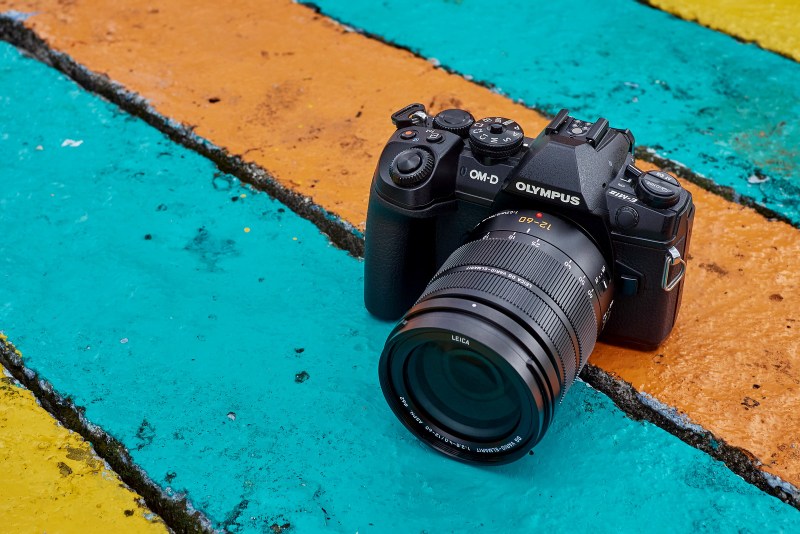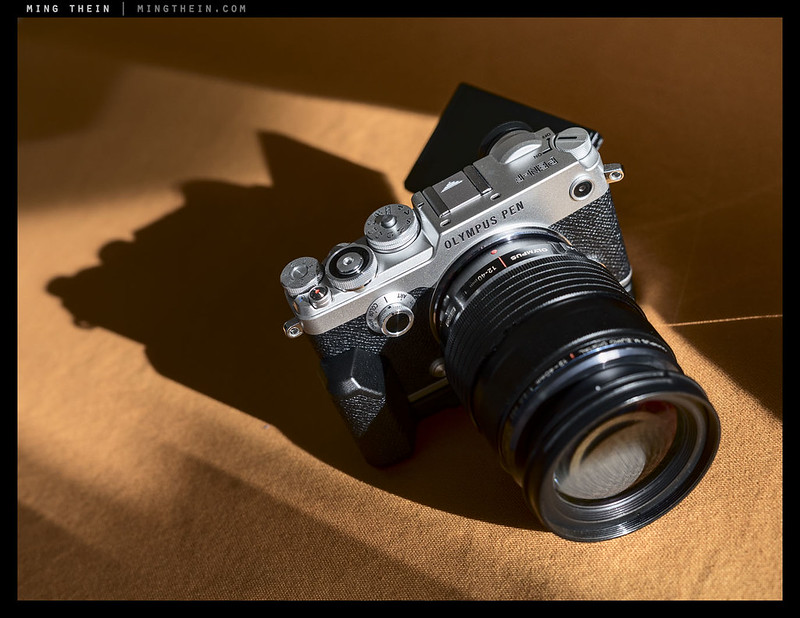Olympus and Panasonic have been releasing increasingly similar and overlapping lenses as the Micro Four Thirds system matures. More options and choice can definitely be seen as an advantage. Early this year, in January, Panasonic released the Panasonic Leica DG Vario-Elmarit 12-60mm F2.8-4.0 zoom lens. The other competitors for a similar zoom lens are: the Panasonic 12-35mm F2.8 and Olympus 12-40mm F2.8 at about the same price as the new 12-60mm F2.8-4. For a premium, you can have the Olympus 12-100mm F4, and at the lower end there is the Panasonic 12-60mm F3.5-5.6. There is no shortage of standard zoom lenses. Therefore in this review, I shall explore the capabilities of the Panasonic 12-60mm F2.8-4 and discuss how this lens stands out from the rest of the crowd. [Read more…]
Street photography with the Olympus E-M10 Mark III
Traditionally, I always bring a new camera to the streets to shoot for review. For the recently launched Olympus OM-D E-M10 Mark III (full review here), I decided to shoot a different variety of sample shots which included sports, outdoor portrait and landscape. I am all game when it comes to doing something different to keep my reviews fresh. Still, since I had the E-M10 Mark III with me for a few more days, I had to satisfy the itch to have my shutter therapy on the streets. [Read more…]
Premiere and review: The Olympus PEN F
After being limited to 16MP for nearly four years, we now have a marginal increase in resolution – to 20MP, matching the Panasonic GX8 announced last year (and quite possibly sharing the same sensor, too). The PEN F is another retro-tastic design clearly inspired by the original film half-frame PEN F, right down to the knob on the front vertical face of the camera. It is also yet another subdivision of a niche by Olympus of its EVF cameras – we have the photo-centric E-M1, the video-centric E-M5II, the budget-centric E-M10II, and now the PEN F. One thing that struck me throughout the test period was that the camera really feels as though it’s geared towards the JPEG shooter (or, more likely, the social media crowd). It’s the first all-new ‘serious’ camera from Olympus in a couple of years – so how does it perform?
Thank you to Olympus Malaysia for the loan. Note that all images were processed in Olympus Raw Viewer 3, and then run through my usual photoshop workflow; as such it’s difficult for me to make objective and comparative statements about image quality as this is not my normal workflow and one cannot compare it to other cameras easily. What I can do for now is assess how this particular workflow performs, and that’s what I’ll be doing later. Additional images will be posted to this flickr gallery.
Review: The Olympus E-M5 Mark II
My usual deployment: handheld video, with HLD-8 battery grip, Zeiss ZM 1.4/35 Distagon rin an adaptor, and a Zoom H5 audio recorder. I am working on fixing the hard/sharp/uncomfortable edges of the battery grip with a silicone putty compound called Sugru, and will post the results in a future post.
Better late than never (or, I finally get around to trying out the second coming): the Olympus’ E-M5 Mark II. Many of the long-suffering readers of this site will know that I had a period of enthusiasm for M4/3 gear (and specifically the original E-M5) before that abruptly came to a halt in early 2014. The reasons were simple: firstly, camera technology has moved on; what was an impressive size/quality ratio in 2012 is not in 2015. Secondly, my output requirements have changed; the cameras have never had sufficient resolution to make a meaningfully-sized Ultraprint. Thirdly, there was no real solution to the shutter shock problem of the E-M1, which produced unusable images under basically every shooting condition – from 1/90s to 1/350s*. We were amongst the first to use the original E-M5 for video because of its stabiliser, and continued to use the E-M1s for video (including all of the workshop videos after The Fundamentals), Olympus and I then parted ways, and it appears they found new champions less demanding of their equipment. But, why the change of heart for me?
*I demand critically sharp pixels and can achieve them with the same camera under other conditions. Different users may have different thresholds of acceptability and different levels of shot discipline and not see any problems. On top of that, I tested >80 E-M1 bodies including >70 at Olympus Malaysia HQ, all of which exhibited the problem. The initial review unit did not, because it was a preproduction unit with a shutter module from a different batch. A firmware update was subsequently released with EFC, but it only works in single shot mode.
Photoessay: Avril Lavigne, live in Kuala Lumpur
Here’s something you probably weren’t expecting from me. Though I’ve shot concerts on assignment before (here, for instance) I don’t tend to go very often as a fan, simply because I don’t have the time, and even if I did, most of the acts I’d want to listen to don’t come to Kuala Lumpur.
Photoessay: Universal Studios Singapore
A continuation of the previous article on tourist location photographability.
Perhaps as a reflection of personal interest, I was certainly more drawn to the urban scenery element of the place rather than the rides or the fantasy areas; none of the people really fit the scene – i.e. looked ‘in place’, so I left them out (think 1940s New York or 1960s Hollywood being full of Asians in tank tops and shorts). The results are a slightly surreal and empty environment; I think it reflects my recent and increasing fascination with form and light over action. We all go through subject and stylistic shifts in our photographic journey as we explore new things; having shot a lot of street, cinematic and reportage work in recent years, perhaps it’s time for a change.
Lens review: The Olympus 12-40/2.8 M.Zuiko PRO
Announced and available together with the new OM-D E-M1 (reviewed here), the 12-40/2.8 M.Zuiko Digital PRO (24-80mm equivalent) is the first in a new line of M.Zuiko Digital PRO lenses. Development of an equivalent-grade f2.8 fast telephoto zoom was also announced, with a 2014 release. Thanks to the folks at Olympus Malaysia, I’ve had the opportunity to use this lens together with the new camera for some time now. Read on for my review.
Advanced warning: Flickr will apparently be down for maintenance for a little while on Friday 13/9, so if some images don’t appear, it’s because they’re hosted there…
The 2013 Olympus OM-D E-M1 review, part two: some comparisons
In part one yesterday, I looked at the camera as a standalone device with few references to its predecessor or competition; today we’re going to examine some of the technical differences in a bit more detail against two benchmarks: the outgoing OM-D E-M5, and the Nikon D600. Both are 2012 cameras, and cameras that I’m intimately familiar with because I use them heavily in the course of my normal work – the E-M5 as my travel/teaching camera, and the D600 for video and backup to the D800E. The former is a no-brainer; the latter is perhaps a bit more of a stretch: not only is there a significant price difference, but the sensor goes up in size by two whole notches – it’s effectively four times the size of that in the E-M1. Surely this is an unfair fight?
Update: ISO comparison chart mislabelling fixed, and I am checking on the 12 vs 14bit issue. Olympus confirms files are 12 bit.
The 2013 Olympus OM-D E-M1 review, part one: the camera
The late-2013 OM-D E-M1 is the successor and upgrade to the very popular early-2012 OM-D E-M5. It’s now clear why the camera was launched with a mouthful of two names: OM-D is a line of products, E-Mx is the model. In this review, we will refer to them as E-M1 and E-M5 respectively to avoid confusion. As you all probably know, I’m very familiar with the E-M5; this camera has served as my travel and teaching camera for the last year, and has now clocked somewhere north of 40,000 exposures (I also reviewed it here). What’s changed in a year? Quite a lot, it seems: certainly enough to get excited about. There’s also a new confirmed lens – the 12-40/2.8 M.Zuiko PRO, available with the camera, and a matching f2.8 telephoto for next year.
This review will be in three parts for ease of reading (this part is already north of 4,400 words) – the camera itself, today; a relative comparison with two other benchmarks, tomorrow; and a review of one of the two lenses announced with the camera shortly thereafter – the 12-40/2.8 M.Zuiko PRO. A quick note on testing methodology: a range of lenses were used for the review, including the new 12-40, the 50-200/2.8-3.5 SWD for 4/3rds, the 12, 45, 60 and 75mm primes, and the Panasonic 14-42X. You won’t find full size images here due to image theft/ IP issues; go by what I say not what you see – there’s an enormous difference between a small web JPEG that’s been attacked and oversharpened by Flickr’s downsizing algorithm and a full sized one or a RAW file in any case, plus of course the monitor matters. There will be 100% crops where noted, however.
A set of images shot with the E-M1 will be here on my flickr page, and continuously updated as I use the camera more.
Review updated 18 September to include comments on RAW file quality, post ACR 8.2 release.
Photoessay: New York City urbanscapes
I honestly have no idea what category or genre this kind of photography falls into; it’s not quite abstract because you know what the subject is, though there’s heavy reliance on geometry, form, color and light; it’s not street even though it’s generally shot on the street or from the street; I suppose it could be travel, though they don’t really especially make you want to go visit a place. Flaneur, perhaps; the exploring observer. Or still life, except there are frequently moving elements. It’s not really cityscape or architecture either, because often there are no buildings, or they’re not complete, or the view isn’t wide enough to be considered an entire cityscape.














